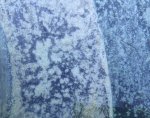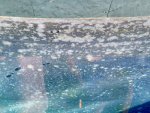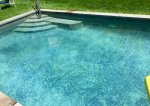Michael is correct. This is a typical dark colored plaster that is also probably suffering from a second mistake.
The original problem with the plaster is known as white porous or soft spotting (also incorrectly called "spot etching" by some). See link that Michael posted.
First, the plaster crew adds too much calcium chloride (hardening accelerator) to the plaster mix so that it takes less time to complete the pool. That leads to the plaster hardening too quickly before the plaster surface can be made smooth, then the finishers splash water onto the plaster surface and trowel that water back into the plaster surface to make the surface smooth. That is what led to the original problem of spotting.
The defective plaster surface caused by the above issues leads to porous areas or spots that will soon lose the pigment color within the plaster when submerged in water. Porosity also lightens the color of all plaster finishes. It usually takes a some months to whiten if the water is generally balanced, but the white spots will remain as smooth as the surrounding (dark color) areas. If the water is aggressive from the start, then the white spotting will occur much faster.
The second problem, and as you determined for yourself, the white spots are now rough and pitted. That means that the pool water has been aggressive, at least for a period of time. That is why the defective plaster spots are now rough, sunken, and pitted. However, I will say that since the pool is at least 7 years old, the deterioration and erosion of those defective white areas or spots could be simply from long term wear of being submerged in balanced water. But your water tests indicate aggressive presently, so it is hard to tell what role the aggressive water has played in that pool, but aggressive water will certainly make the surface pitted and compound the problem.
A re-plaster company would probably either remove the old plaster, or etch the plaster surface by acid or sandblasting, and then place a new plaster coat job over the top.




